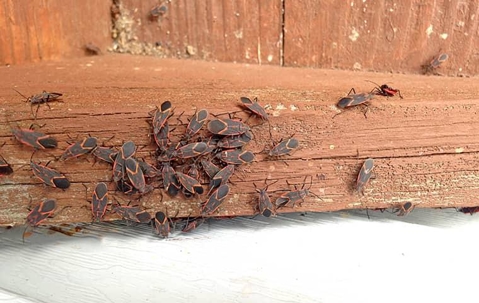Have you ever seen a boxelder tree? Would you know one if you saw it? Boxelder is such a peculiar name but is actually a type of maple tree. It is an unusual maple tree as it has rounded buds, compound leaves that are ash-colored, and thick twigs. The twigs will change from powder blue to purplish-green throughout the changing seasons. They are typically found in western states but can also be found in the eastern part of the states and up into eastern Canada. Boxelder trees are native to Utah. Unfortunately, wherever you find a boxelder tree, you will most likely find boxelder bugs.
If you see a black, flat elongated oval looking bug with reddish and orange markings on its back, then you have probably spotted a boxelder bug. They typically are about an inch long. The adults have six legs and two antennae the grow to be half of their body length. They also have one set of wings. The nymphs look similar to adults but are bright red and lack wings. Boxelder bugs can be a real nuisance because not only will they ruin trees, but they will also leave the trees in the winter to enter buildings such as your house, garage, and shed! They tend to hide in small crevices and cracks to insulate themselves from cold temperatures.
What Are The Habits of Boxelder Bugs?
After the winter season, adult boxelder bugs will come out from their indoor hibernation to enjoy the opening of the boxelder buds. They will first feed on the seeds that have fallen from their host trees. Occasionally, they will also feed on the fruits from apple and plum trees, but they are mainly attracted to boxelder trees. Therefore, that is where they will do the most damage.
Females will lay their yellow eggs in clusters on eaves, shrubs, stones, grass, and in trees. They are particularly drawn to the crevices in boxelder trees. As the embryo develops, they turn red and hatch approximately two weeks later. The fresh hatch will also feed on fallen seeds from the boxelder and then move on to leaves. In the warmer regions of the United States, they will produce two generations per year.
Removing Boxelder Bugs From Your Property
To keep these pests from invading your home and outbuildings, you can implement the following preventative measures:
- Install door sweeps to all exterior entrances.
- Seal cracks and crevices with silicone or silicone-latex caulk.
- Repair any holes in door and window screens.
- Set boxelder bug traps.
It may be tempting to kill boxelder bugs that overwinter in your home. However, doing so will attract beetles. Experts suggest waiting until summer when all live adults are out of the walls. If you would like some temporary relief from them during the winter months, sweep them up with a vacuum cleaner. Once you are done, be sure to dispose of the vacuum bag.
Boxelder bugs find their way into the cracks and crevices of your home. To get them out of your walls, you will have to do some light electrical work. With electrical outlets, switch boxes, heating ducts, and air vents, remove the cover plate, seal, and replace. For ceiling fans and light fixtures, remove their base plate, seal, and replace
Professional Help To Control Boxelder Bugs
If you suspect that you have a boxelder bug infestation, we strongly suggest contacting us at Pest Pro Pest Control. We will begin by inspecting your property to understand the extent of the infestation. From there, we will come up with a plan for removal and suggest strategies to keep these pests away in the future. We are more than happy to provide you with on-going services, which is the best way to ensure box elder bugs stay out of your home and outbuildings.

